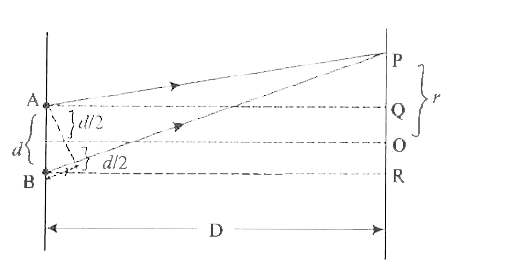InterviewSolution
Saved Bookmarks
| 1. |
Obtain the expression for fringe width of interference fringes in Young's double slit experiment. |
Answer» Solution : A and B REPRESENTED two coherent SOURCES separated by a distance d. Let a screen be PLACED at a distanceD from the sources. The point `THETA` on the screen is equidistant from A and B . It is given BP-AP=`delta` eqn.(1)-(2) Then `delta=BP^2-AP^2` In the `triangle^"le"` BRP, `BP^2=BR^2+PR^2=D^2+(PO+OR)^2` `BP^2=D^2+(x + d//2)^2`...(1) In the `triangle^"le"` APQ, `AP^2 =AQ^2 +QP^2 =D^2 + (OP-OQ)^2` `AP^2 =D^2 +(x - d//2)^2` ....(2) `BP^2-AP^2=D^2+(x+d//2)^2 -D^2 +(x-d//2)^2` `=[D^2+x^2+d^2/4+2xd//2] -[D^2+x^2+d^2/4-2xd//2]` `=cancelD^2+cancelx^2+cancel(d^2/4)+XD -cancelD^2-x^2-cancel(d^2/4)+xd` =xd+xd=2xd `(BP^2-AP^2)=2xd` (BP-AP)(BP+AP)=2xd `BP-AP=(2xd)/((BP+AP))` BP-AP=`(cancel2xd)/(cancel2D)` P is very close to D Path Difference `Delta=(xd)/D "" Delta` is not shown in drawing . For constructive interference `delta=nlambda` `nlambda=(xd)/D rArr x=(Dnlambda)/d` `x_1=(Dlambda)/drArr x_2=(2Dlambda)/d` The distance between the centers of any two consecutive bright fringes is called the fringe width. `beta=x_2-x_1=(2Dlambda)/d-(Dlambda)/d` `beta=(Dlambda)/d` |
|